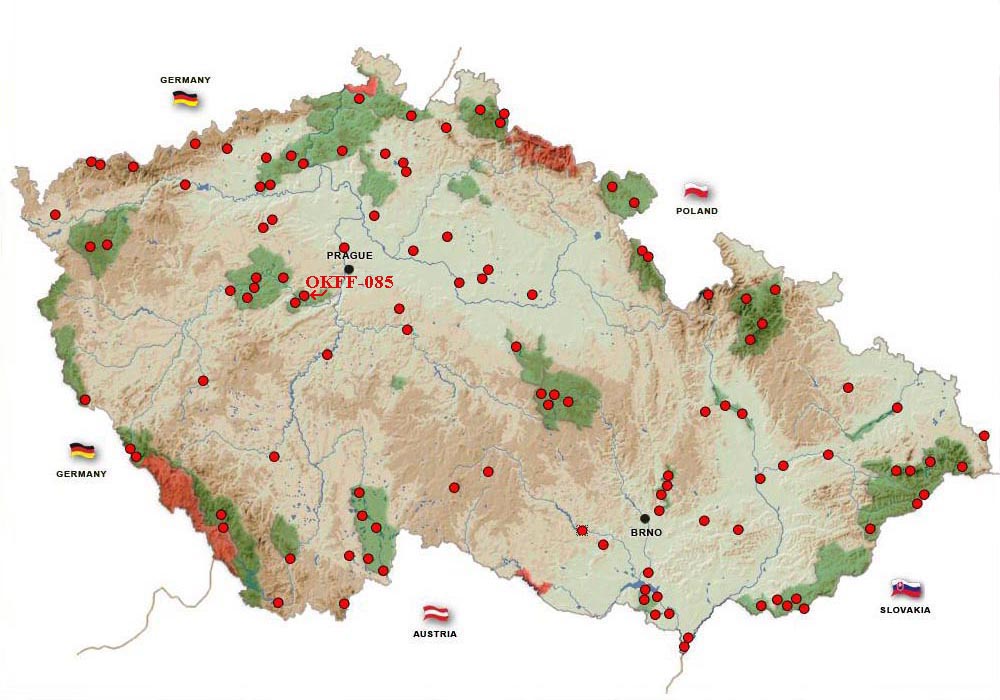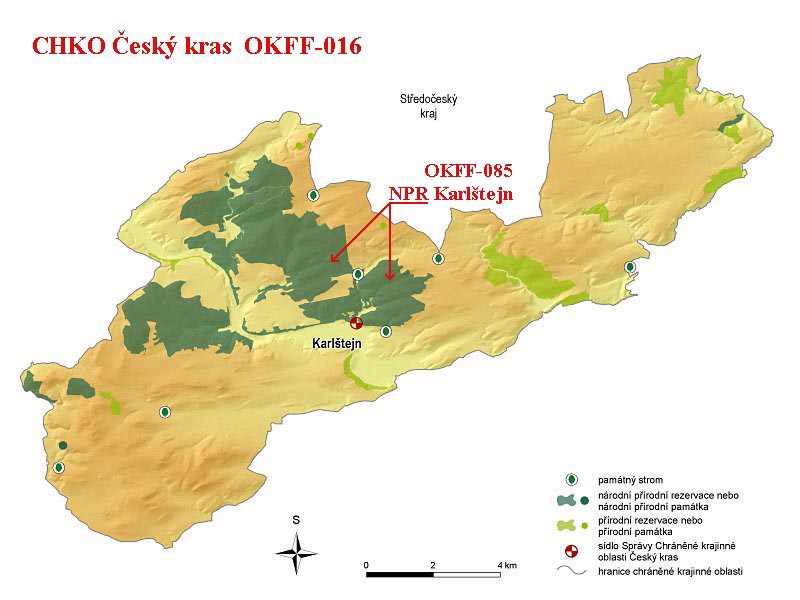Flora & Fauna - Czech Republic
NNR Karlštejn - OKFF-085
Basic data:
Designation: 26. dubna 1955,
Area: 1.547 ha,
Height above sea level: 216 až 440 m .
The Karlštejn NNR was declared in 1955 on a territory of 1 547 ha, which makes it the largest specially protected area within the Český kras (Bohemian Karst) PLA. This predominantly forested territory lies to the north of the Berounka river, between the town of Beroun and the villages of Vráž, Mořina, Karlštejn and Srbsko, in the Středočeský kraj – Central Bohemian Region, and is divided by the valleys of the Budňanský, Bubovický and Loděnický streams. The Karlštejn NNR territory is part of the proposed Karlštejn – Koda Site of Community Importance.
On the naturally exposed rocks and in the former quarries we can observe the geological layers from the Lower Silurian to the Middle Devonian by way of stratographical profiles. The Budňanská skála rocks at Karlštejn are a world-renowned parastratotype. In the western section of the NNR, at Svatý Jan pod Skálou in the Berounka valley we can see a profile of the volcanic facies of the Silurian period. The paleontological localities and the surface and underground karst phenomena in this area are also of international renown. Deposits of calcareous tuffa formed around the karst resurgences during the Quaternary period. According to the character of the tuffa layers we can recognise the changes in climate in the recent geological past.
With regard to the limestone basement and variety of relief types, a wide range of biotope types are found on the Karlštejn NNR territory. Alluvial forest stands can be found in the stream valleys and talus and ravine forests grow on the steep shaded rocky slopes. The most widespread forest type is the oak-hornbeam forests. Beech forests with helleborines can be found on the damper northern slopes while white or pubescent oak (Quercus pubescens) stands with cinquefoils and vetches grow on the dry southern slopes and also include cornelian cherry (Cornus mas), the vetchling Lathyrus pannonicus subsp. collinus, yellow pheasant’s eye (Adonis vernalis) and the endemic karst variety of rowan (Sorbus eximia). Xerophilous and thermophilous forest-free communities such as fescue and moor-grass grasslands are found on the rocky outcrops and on southern and western slopes. Here we can find the endangered Austrian dragonhead (Dracocephalum austriacum) which only grows in the Bohemian karst within the realms of the Czech Republic. The geological basement of limestone supports a number of wild orchid species, including lady orchid (Orchis purpurea) and white helleborine (Cephalanthera damasonium). The lily-leaf lady bells (Adenophora liliifolia), which is gradually disappearing, grows in several places in the oak-hornbeam stands. A large number of calciphilous mosses and also thermophilous fungi species grow here and some of these are very rare, e.g. royal bolete (Boletus regius), scarlet elfcup (Sarcoscypha austriaca) and the summer truffle Tuber aestivum.
Karlštejn NNR can also boast a rich variety of fauna, especially of invertebrates. Many gastropods are bound to the limestone basement, including the snail Chondrina avenacea, which is found nowhere else in the Czech Republic except for Český kras PLA. Our largest beetle – the stag beetle (Lucanus cervus) inhabits the natural deciduous forests. The thermophilous grasslands are the habitat of the owlfly Libelloides macaronius and the ladybird spider Eresus cinnaberinus. The great crested newt (Triturus cristatus) can be found in the Paraple abandoned quarry. Eagle owls (Bubo bubo) nest in the abandoned quarries in the area while the honey buzzard (Pernis apivorus) and goshawk (Accipiter gentilis) nest in the forests. The barred warbler (Sylvia nisoria) occurs on the steppe areas along the Berounka river and the kingfisher (Alcedo atthis) hunts along the Loděnický potok stream. The large number of underground shafts and caves are notable hibernating sites for many bat species, including the barbastelle bat (Barbastella barbastellus) and greater mouse-eared bat (Myotis myotis). We could also encounter lesser horseshoe bats (Rhinolophus hipposideros).
Evidence of prehistoric human settlement has been discovered in many of the caves on the Karlštejn NNR territory. According to Medieval legends the hermit St. Ivan lived in a karst cave in the pile of calcareous tuffa at Svatý Jan pod Skalou. Karlštejn NNR was awarded the prestigious European Diploma by the Council of Europe in 2000 as recognition of its significance as a part of the European cultural and natural heritage.
A number of marked trails pass through the NNR territory. We recommend that you take the red marked trail from Karlštejn castle towards the Seven brothers oak tree and on to the Králova studna spring and the Bubovický waterfall, around Doutnáč hill to Svatý Jan pod Skálou and finally to the town of Beroun. By following this route we will also walk along sections of two circular themed trails: the Svatojánský okruh (which starts and finishes in Svatý Jan pod Skálou) and the Karlštejn trail (which has access points in Srbsko and Karlštejn).

Map NP, PLA and NPR in the Czech Republic.

Map NNR Karlštejn in PLA Bohemian karst OKFF-016.
Source: http://www.cittadella.cz .
|
|
|